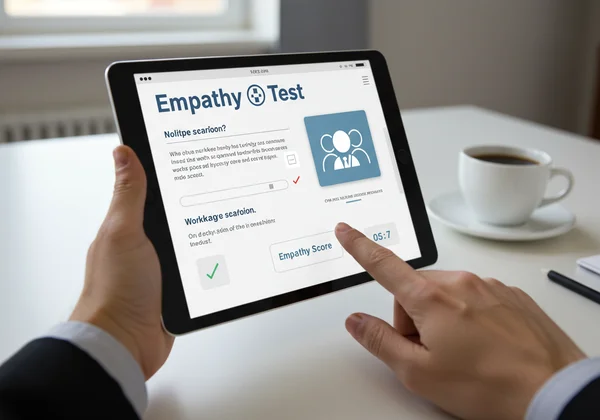Leadership Empathy Test: A Guide to Boosting Workplace Connection
In today's fast-paced professional world, managers grapple with persistent challenges: communication breakdowns, disengaged teams, and costly employee turnover. We often search for complex strategic solutions, but one of the most powerful drivers of success is frequently overlooked. We’re talking about workplace empathy, a critical asset that transforms team dynamics and elevates leadership. But how do I know if I'm empathetic enough to lead effectively? This guide will explore why empathy is a non-negotiable leadership skill, how you can cultivate it, and how to measure your own baseline to unlock your team's full potential. The first step is self-awareness, and you can discover your empathy score to begin.
Why Leadership Empathy Drives Team Success
Effective leadership goes beyond directives and deadlines; it’s about connection. Leadership empathy is the cornerstone of a thriving, resilient, and innovative team. When leaders demonstrate a genuine understanding of their team's perspectives and feelings, it creates a ripple effect that directly impacts the bottom line. This isn't just a "nice-to-have" soft skill—it is a strategic imperative for modern management and robust team building.

The Tangible Business Case for Empathetic Leadership
Investing in empathy yields measurable returns. Studies consistently show that empathetic workplaces report higher employee engagement and morale. When employees feel seen and understood, their loyalty and commitment deepen, leading to significantly better retention rates. This environment of trust also fosters superior collaboration, as team members are more willing to share ideas and offer support without fear of judgment.
Google's famous "Project Aristotle" found that psychological safety—a direct outcome of empathetic leadership—was the most critical factor in building successful teams. Empathetic leaders create spaces where creativity flourishes and problem-solving becomes a collective effort, ultimately driving organizational performance and profitability.
Differentiating Cognitive & Emotional Empathy in Management
To effectively leverage empathy, it's crucial to understand its different forms. The two most relevant types for managers are cognitive and emotional empathy, which are key components of emotional intelligence. Understanding your strengths in each can be revealed with our online empathy test.

- Cognitive Empathy: This is the ability to understand someone else's perspective, thoughts, and mental state. For a manager, this is vital for negotiating contracts, giving constructive feedback, and strategizing with team members by anticipating their reactions and needs.
- Emotional Empathy: This is the ability to share the feelings of another person—to feel what they feel. This is essential when supporting an employee through a personal struggle, managing team conflicts, or celebrating a collective win.
A great leader knows how to balance both. Relying solely on cognitive empathy can appear cold and calculating, while being overwhelmed by emotional empathy can lead to burnout and biased decision-making. The goal is to understand intellectually and connect emotionally, applying the right type of empathy to the right situation.
Cultivating Workplace Empathy: Actionable Strategies for Managers
The good news is that empathy is not a fixed trait; it is a skill that can be learned and strengthened through conscious practice. For leaders committed to professional development, focusing on specific techniques can create a more connected and effective work environment.
Mastering Active Listening and Perspective-Taking
True empathy begins with the desire to understand, and that requires shutting out the internal noise and truly listening. Active listening is more than just hearing words; it's about absorbing the full message, including the non-verbal cues. Managers can practice this by:
-
Asking open-ended questions to encourage deeper sharing.
-
Reflecting and paraphrasing what you've heard ("So, what I'm hearing is...") to confirm understanding.
-
Avoiding interruptions and the urge to immediately solve the problem.

Perspective-taking is the next step. Regularly schedule one-on-one check-ins with the sole purpose of understanding your team members' experiences. Ask questions like, "What are your biggest challenges right now?" or "What would make your work more fulfilling?" This conscious effort to see the world through their eyes builds powerful bridges of trust and improves your communication skills.
Building an Empathetic Team Culture and Communication
A leader's empathy sets the tone for the entire team. To embed empathy into your organization's DNA, focus on fostering psychological safety. This means creating an environment where team members feel safe to take risks, admit mistakes, and be vulnerable without fear of negative consequences. Encourage open feedback channels and model transparent communication.
Recognizing and celebrating diverse backgrounds and perspectives is another cornerstone of an empathetic culture. When team members feel their unique identities are valued, they are more likely to contribute fully. Addressing the need for HR empathy in policies and interactions ensures that this value is institutionalized. A leader's journey toward building this culture starts with self-awareness, and taking a free empathy test is a powerful first step.
Leveraging Our Empathy Test Platform for Your Professional Growth
While theory lays the groundwork, practical tools are what truly accelerate your growth. To truly improve, you need a clear understanding of your starting point. Our platform provides a scientifically designed empathy assessment to bridge the gap between knowing you should be empathetic and knowing how empathetic you currently are.
Self-Assessment: Unlocking Your Leadership Empathy Score
The first step toward targeted improvement is honest self-assessment. Our empathy test offers an objective, data-driven look at your empathetic tendencies. It moves beyond guesswork and provides a concrete empathy score based on your responses to various scenarios rooted in psychological principles. This awareness is invaluable for any professional, especially those in leadership roles who are shaping team environments. Are you ready to discover your baseline? You can start your self-assessment in just a few minutes.

Personalized Insights and Action Plans for Managers
What truly sets this tool apart is the option for an AI-enhanced personalized report. This isn't just a number; it's a roadmap for your development. The report provides a deep dive into your specific strengths and potential challenges as a leader. It translates your score into real-world implications for managing your team, offering bespoke action plans to enhance your soft skills. This targeted feedback empowers you to focus your efforts where they will have the most impact, turning insight into tangible leadership improvement. To see how it works, you can get your personalized report after completing the test.
Lead with Heart, Lead with Impact
Empathy is no longer on the periphery of leadership qualities; it is at the very core of what makes a modern leader successful. By fostering greater workplace empathy, you build teams that are not only more productive and innovative but also more resilient and humane. The journey begins with understanding yourself, proceeds with conscious practice, and results in a more engaged and successful workplace.
Ready to transform your leadership and unlock your team's true potential? The path to becoming a more empathetic leader starts with a single step. Take the empathy test today to discover your unique score and begin your journey toward leading with greater impact.
Common Questions About Empathy in the Workplace
How can a manager accurately assess their own empathy level?
Self-perception can be biased. The most effective approach combines self-reflection with objective tools. Start by asking for 360-degree feedback from peers and direct reports. For a standardized and confidential measure, an online assessment designed on psychological principles is invaluable. Our comprehensive online empathy test provides a structured way to understand your empathy levels without guesswork.
What are the main obstacles to developing empathy within a team?
Several factors can block empathy in a professional setting. High-stress environments, tight deadlines, and a culture that prioritizes results over people can all hinder connection. Unconscious bias, a lack of diversity, and remote work structures that limit personal interaction can also create barriers. Overcoming these requires intentional leadership focused on building psychological safety and open communication.
Can a manager without high empathy still be an effective leader?
A manager can be effective at executing tasks without high empathy, but they will likely struggle to be a truly great leader. Great leadership involves inspiring, motivating, and retaining top talent—all of which are deeply rooted in empathetic connection. The good news is that empathy is a developable skill. A leader who recognizes a deficit and commits to growth can become highly effective.
How does professional development specifically improve workplace empathy?
Targeted professional development can significantly boost empathy. This includes training in active listening, workshops on unconscious bias, and coaching on emotional intelligence. A crucial first step in any development plan is establishing a baseline. Using a comprehensive empathy quiz allows leaders and HR professionals to identify specific areas for improvement and track progress over time, ensuring development efforts are effective.